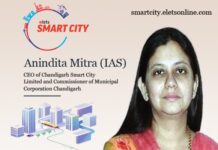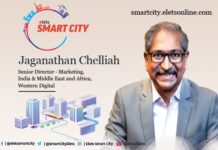
Smart Cities Mission is not only about the implementation of projects. The Mission aims to build capacity of cities to think strategically about Urban Development, says Kunal Kumar, Joint Secretary (Mission Director Smart Cities), Ministry of Housing & Urban Affairs, Government of India, in conversation with Ritika Srivastava of Elets News Network (ENN).
 The Government of India has embarked upon the ambitious ‘Smart Cities Mission’ to transform India’s urban landscape. Please share the progress of this programme?
The Government of India has embarked upon the ambitious ‘Smart Cities Mission’ to transform India’s urban landscape. Please share the progress of this programme?
All 100 cities covered under the Mission have constituted their SPVs, appointed PMCs, and established their city level advisory forums. As part of their SCPs, 100 cities have proposed 5,151 projects worth Rs 2,05,018 crore.
The pace of implementation of the Mission has increased significantly and is one of the fastest in terms of progress. From projects worth 33,970 crores tendered, and those worth 19,041 crores under implementation/completed in January 2018 the corresponding figures have increased by 288 percent and 355 percent as on March 2019.
But Smart Cities Mission is not only about the implementation of these projects. The Mission aims to build capacity of cities to think strategically about Urban Development. It is setting a template for future development, establishing new institutions, concepts and developing institutional and professional capacity to make Indian cities cater to citizens needs in the best possible way.
How technology and innovations are playing an important role in providing services to the citizens under the Smart Cities Mission?
Smart cities are envisioned as cities that focus on improving the quality of lives of their citizens, thereby creating a robust environment for sustained economic growth and innovation. The cities have initiated projects to confront the major issues faced by the citizens and are at varying levels of progress.
In a very short period the results are very encouraging: Rajkot recorded an increase in on-line issuance of birth/death certificates, and through surveillance, crime rate has gone down; Improvement in traffic challans in Ahmedabad; Pune has installed flood sensors at key points around the city which feed data to the smart city centre, thereby, enabling timely warning and response mechanism; In Vishakhapatnam, CCTV and GPS enabled buses are being tracked online through the Smart City Centre; and Bhopal has seen a rise in its property tax collections and is able to track its transport services online.
Smart cities leverage ICT-based technologies and digitalisation to make governance citizen-friendly and cost effective; bring about accountability and transparency; provide services without having to go to municipal offices; form e-groups to listen to people and obtain feedback; and use online monitoring of programs and activities with the aid of online tools. By now, 16 Smart Cities have operationalised ICCCs; and work is in progress in another 55. Integrated Command and Control Centres (ICCC) are helping cities in better urban planning and management. ICCCs function as single source of information and point of resolution of the civic functions of the city. They are bringing transparency through information sharing, a step towards becoming an inclusive city. Some of the ways ICCCs impact citizens’ lives are:
- Improved decision making for (local and other levels of) governments
- Improved environmental sustainability and climate change outcome
- Improved quality of services to citizens
- Safety of citizens
- Making cities more inclusive
How smart transportation is contributing towards urban growth of cities?
Smart transportation leverages smart infrastructure that includes multi-modal connected conveyance, automated traffic signals, tolls and fare collection. Data integration—incorporating weather and traffic data, linking emergency services data as well as information from government agencies— drives the system. A central command centre ties together the smart transportation ecosystem, with real-time and updated data, handling passenger information, traffic signals, incident management and vehicle health monitoring.
The optimised ‘on-demand services’ ensure that citizens use all modes of transport according to their needs. Shared mobility solutions help provide first and last mile connectivity in conjunction with public transportation, they can act as feeder services and improve access to metro/rail or bus services.
We are aiming to make public transportation robust and accessible through multi-modal shared mobility, so that citizens can choose it for all their commuting needs be it travel for work, travel for daily needs or for leisure. This can help move people away from private vehicles, which can contribute to lowering congestion and pollution.
Cities under the Mission are using technology to develop such seamless and connected transportation systems. Technology driven smart public transportation offers more attractive, reliable, convenient and complete choice of mode to commute. This reduces dependency on cars, arrests urban sprawl, and enables city authorities to develop compact cities with more focus on moving people rather moving cars. Fewer cars on roads will also reduce city’s air pollution levels. Moreover, with the continuous advancement in development of electric vehicles, smart transportation is destined to transform cities to zero emission mobility smart cities.
In the Mission cities till date, a total of 734 smart transportation projects worth Rs 28,000 crore are under implementation/completed. Electric mobility projects worth Rs 601 crores are under implementation/completed in 21 cities. As many as 16 smart cities have operationalised ICCCs worth Rs 2,927 crore; and work is in progress in another 44 cities worth Rs 4,170 crore. Public transport operations and traffic management are integral part of all ICCC enabled cities. Some cities have independently created Integrated traffic Management Systems (ITMS) to better manage their public transport operations. Smart Roads worth Rs 5,146 crore are under implementation/ completed in 35 cities.
MoHUA often talks about integrated urban development as the answer to rapid urbanisation in India. Can you please explain this approach?
Due to rapid phase of urbanisation and sheer concentration of people and assets in cities, their vulnerability to the impacts of climate change, disasters and conflicts increases manifold. This will result in unsustainable development, rising inequality and exclusion within cities.
However, when planned and managed with a well-defined vision, cities become engines of growth, inclusive and sustainable. Such cities attract talent and investment. While a few new cities might need to be built, which could be ‘specialist cities’ along the new industrial/transport corridors and satellite towns in proximity to existing big cities, a renewal of all cities is a must.
Our government saw these challenges and the big opportunities to improve citizens’ lives as well as drive the economy forward. Investments in infrastructure create jobs, improve ease of living and employ citizens the best of their abilities in service of the nation. Traditional interventions have mostly focused on physical improvements such as slum upgrading, making flyovers and roads etc. But we at MoHUA have taken a holistic approach that integrates all dimensions of urban development – social, economic, environmental and governance. Therefore, a three-level strategy is now being implemented:
- At the first level government programmes related to poverty alleviation, affordable housing and cleanliness are implemented in all, more than 4,300, urban local bodies.
- At the second level the government programmes tackling the issues of basic infrastructure like water supply and sewerage/septage projects and green parks are in the focus. This covers 500 cities and over 65 percent of urban population.
- At the third level, 100 cities are being developed under Smart Cities Mission (SCM).
What were the new initiatives taken by the Ministry?
To ensure that optimum development takes place across all cities we have recently initiated new path breaking initiatives, which include India Urban Observatory, National Urban Innovation Stack (NUIS), DataSmart Cities Strategy, DataSmart Cities Assessment Framework, National Urban Learning Platform (NULP), Ease of Living Index 2019, Municipal Performance Index 2019, ClimateSmart Cities Assessment framework 2019, National Urban Policy Framework (NUPF), India Smart Cities Fellowship (ISCF), Smart Cities Digital Payment Awards-2018, among others.
What are the main challenges of this Mission?
Any Mission of this scale is going to come across several challenges of different nature. At the start of the mission, one of the biggest challenges was to create an institutional framework at city level. We are very proud to say that in a short span, all 100 cities have incorporated their SPVs for program implementation. This is for the first time, city level SPVs have been created for comprehensive urban development in India.
Another challenge was to build the capacity at city level to take up innovative technology solution. Smart Cities have created an ecosystem wherein technology providers, innovators and urban experts have come together towards the realisation of smart city objectives.
Another major challenge is to leverage the grant being provided by the governments. Innovative financing models like issue of municipal bonds, developing PPP projects and formulating value capture policies are required. As you are aware the cities have taken the first step by leveraging the government grant by 2–2.5 times (average) in their Smart City proposals.
Finally, as you are aware, during planning of the smart cities we had one of the most intensive citizen consultations ever. It is however a challenge to continue this engagement process during the implementation phase, which is now been addressed by the selected 100 smart cities. There is no transformation which happens without facing any challenges. We are today witnessing true transformation of the urban sector. I believe that these challenges are opportunities towards a better future.





















